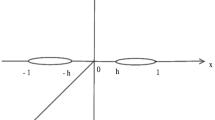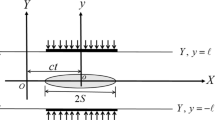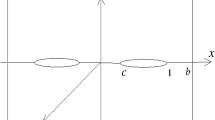Abstract
In this research paper, the diffraction of a Griffith crack, situated in an infinite strip of finite thickness, due to magnetoelastic shear wave propagation has been analyzed. The effect of magnetic field on the Griffith crack interaction has been studied. Fourier transform is used to reduce the mixed boundary value problem to the dual integral equations. Finally, with the help of Abel’s transform the integral equations have been converted to Fredholm integral equation of 2nd kind. Fox and Goodwin method is used to solve the integral equation numerically. The analytical expression of Stress Intensity Factor at the crack tip has been illustrated graphically for the cases with magnetic effect and without magnetic effect.





Similar content being viewed by others
References
Knopoff L (1955) The interaction between elastic wave motions and a magnetic field in electrical conductors. J Geophys Res 60(4):441–456
Chadwick P (1957) Elastic wave propagation in a magnetic field. Actes IX Congr Intern Mech Appl 7:143–158
Kaliski S, Petykiewicz J (1959) Equation of motion coupled with the field of temperature in a magnetic field involving mechanical and electrical relaxation for anisotropic bodies. Proc Vibr Probl 4:1
Chattopadhyay A, Gupta S, Singh AK (2010) The dispersion of shear wave in multilayered magnetoelastic self-reinforced media. Int J Solids Struct 47(9):1317–1324
Gupta S, Bhengra N (2017) Implementation of finite difference approximation on the SH-wave propagation in a multilayered magnetoelastic orthotropic composite medium. Acta Mech 228(10):3421–3444
Loeber JF, Sih GC (1968) Diffraction of antiplane shear waves by a finite crack. J Acoust Soc Am 44(1):90–98
Robertson IA (1967) Diffraction of a plane longitudinal wave by a penny-shaped crack. Math Proc Cambridge Philos Soc 63:229–238
Mal AK (1970) Interaction of elastic waves with a Griffith crack. Int J Eng Sci 8(9):763–776
Srivastava KN, Palaiya RM, Karaulia DS (1983) Interaction of shear waves with a Griffith crack situated in an infinitely long elastic strip. Int J Fract 21(1):39–48
Chattopadhyay A, Singh AK (2014) Propagation of a crack due to magnetoelastic shear waves in a self-reinforced medium. J Vib Control 20(3):406–420
Sarkar J, Mandal SC, Ghosh ML (1993) Diffraction of SH-waves by a Griffith crack in nonhomogeneous elastic strip. Arch Mech 45(3):285–294
Chattopadhyay A, Maugin GA (1985) Diffraction of magnetoelastic shear waves by a rigid strip. J Acoust Soc Am 78(1):217–222
Zhou ZG, Wang B (2005) Investigation of the interaction of two collinear cracks in anisotropic elasticity materials by means of the nonlocal theory. Int J Eng Sci 43(13–14):1107–1120
Fox L, Goodwin ET (1953) The numerical solution of non-singular linear integral equations. Philos Trans R Soc Lond A 245(902):501–534
Maugin GA (1981) Wave motion in magnetizable deformable solids. Int J Eng Sci 19(3):321–388
Acknowledgements
The authors are thankful to the reviewers for their worthy comments to improve this paper. The author Sourav Kumar Panja is also grateful to UGC, New Delhi for the financial support(JRF- NTA Ref. No:191620017887).
Author information
Authors and Affiliations
Corresponding author
Additional information
Publisher's Note
Springer Nature remains neutral with regard to jurisdictional claims in published maps and institutional affiliations.
Appendix
Appendix
Using common finite-difference integration formulae, we can write the following integral as
where \( g_0=g(0),\;g_r=g(0+rh),\;g_n=g(0+nh)=g(1) \) and \( \Delta , \) the difference correction, is a function of the differences of g.
The expression of \( \Delta \) (Using Newton’s Forward Difference) is
Equation (41) can be written as
where \( K(u,t)=uL(u,t). \) Using Eq. (46) for the representation of the integral, we can write Eq. (47) in the form
where K(s, t) denotes the values of K(u, t) at the point (sh, t) . In this equation, we can put any value of t within (0, 1) for which K is defined, but the same \( (n+1) \) values of g, at the equidistant pivotal points in the range (0, 1) have been considered for t. Since g(t) also seems on the right, however, it is preferable to set the \( t' \)s to be pivotal points of (0, 1) . Taking all pivotal points into consideration we can replace the integral equation by a set of \( (n+1) \) linear simultaneous equations represented by
where, K(s, r) denotes the values of K(u, t) at the point (sh, rh) and r takes the values \( 0,\;1,\;2,\cdots ,n. \) Merging the \( g_r \) on the left with those on the right, we can write Eq. (48) in the following form
We obtained the approximate value of \( g_r\;(r=0,\;1,\;\ldots ,n) \) from Eq. (49), in which all the \( \Delta _r \) have been calculated and inserted as corrections to the right-hand side of Eq. (49).
Rights and permissions
About this article
Cite this article
Panja, S.K., Mandal, S.C. Interaction of magnetoelastic shear waves with a Griffith crack in an infinite strip. J Eng Math 126, 2 (2021). https://doi.org/10.1007/s10665-020-10085-0
Received:
Accepted:
Published:
DOI: https://doi.org/10.1007/s10665-020-10085-0




